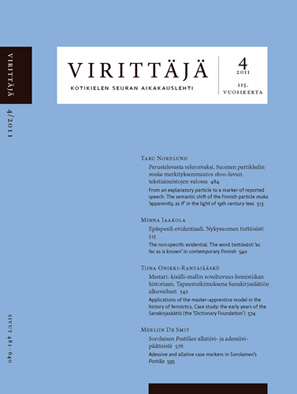Perustelevasta referoivaksi: Suomen partikkelin muka merkityksenmuutos 1800-luvun tekstiaineistojen valossa [From an explanatory particle to a marker of reported speech. The semantic shift of the Finnish particle muka ‘apparently, as if’...]
Abstrakti
Artikkeli tarkastelee suomen kielen partikkelin muka merkityksenmuutosta 1800-luvun tekstiaineistojen valossa. Nykysuomessa muka on pragmaattinen partikkeli, joka ilmaisee, että puhuja ei sitoudu lausumansa totuuteen tai esittää sen ironisesti tai epäillen. Varhaisempien aineistojen valossa nämä merkitykset ovat kehittyneet 1800-luvun kuluessa pragmaattisen päättelyn kautta. Kirjakieleen muka on tullut vasta 1800-luvulla itämurteista, eikä sitä esiinny varhaisimmassa Länsi-Suomen murteisiin pohjautuvassa kirjakielessä.
Tutkimuksen aineisto on koottu Kotimaisten kielten tutkimuskeskuksen 1800-luvun tekstikorpuksesta. Aineisto edustaa kolmea erilaista tekstilajia: luonnontieteellisiä oppikirjoja, satuja ja argumentoivia tekstejä. Koska valitut tietokirjat ovat käännöksiä, niiden pohjalta on ollut mahdollista tulkita mukan merkityksiä myös vertaamalla käännöksiä (ruotsinkielisiin) lähtöteksteihin. Yhtenä aineistona toimiva Eero Salmelaisen satukokoelma kuvastaa lähimmin muka-partikkelin 1800-luvun kansanomaista käyttöä.
1800-luvun aineistojen perusteella muka-partikkeliin on kietoutunut merkityspiirteitä, jotka ovat mahdollistaneet partikkelin käytön erilaisissa konteksteissa sekä sen kehittymisen edelleen. Näitä merkityspiirteitä ovat kausaalisuus eli perusteleva ja selittävä suhde sekä tiedon lähteen ilmaisu. Koska kausaalisen mukan esiintymiskontekstit ovat kansankielessä olleet referointikonteksteja, on kausaalinen suhde voitu tulkita joko perustelevaksi tai selittäväksi. Nykysuomeen tultaessa mukan merkityksen painopiste on siirtynyt tiedon lähteen merkitsemiseen, mikä on vahvistanut lausuman pragmaattisia tiedon varmuuteen liittyviä merkityspiirteitä. Tätä kautta on kehittynyt myös nykykielen mukan affektiivinen merkitys.
Useampien tekstilajien tarkastelu mahdollistaa mukan erilaisten merkityspiirteiden suodattamisen teksteistä, sillä varsinkin nykykielessä vahvasti affektiivisten elementtien tulkinta historiallisesta aineistosta voi olla haastavaa. Tekstilajien tarkastelu rinnakkain osoittaa myös, että semanttisia tai pragmaattisia muutoksia on tarpeellista tarkastella aina myös kvalitatiivisesti lähikontekstista. Suuretkaan korpukset eivät toimi oikotienä, kun halutaan selvittää, missä konteksteissa ja miten merkityksenmuutos on voinut tapahtua.
---
From an explanatory particle to a marker of reported speech. The semantic shift of the Finnish particle muka ‘apparently, as if’ in the light of 19th century texs
The article examines the shift in meaning of the Finnish particle muka ‘apparently, as if’ in the light of a variety of textual sources from the 19th century. In contemporary Finnish muka is a pragmatic particle indicating that the speaker does not guarantee the truth of the statement or that s/he presents the statement in an ironic or doubtful manner. These meanings have developed in the course of the 19th century through pragmatic inferencing and strengthening. The word muka only entered the written language in the 19th century and originated in Eastern Finnish dialects, and it does not appear at all in the earliest written texts based on the Western Finnish dialects.
The material consist of the corpus of 19th-century texts held by the Research Institute for the Languages of Finland. The corpus features three different kinds of text: natural science textbooks, fairytales and argumentative texts. Because the majority of the textbooks are translations, it is possible to infer the meanings of the word muka by comparing the texts with their original (Swedish) source texts. Eero Salmelainen’s collections of fairytales probably also reflects the use of the word muka in 19th-century vernacular speech.
Judging by the 19th-century sources, the particle muka has had a variety of semantic features which have facilitated the particle’s use in diverse contexts and have contributed to its development. These features include the indication of causality and explanation, as well as the evidential nature of the particle. In the contexts of reported speech, the causal relationship could have been interpreted either as explanatory or argumentative. As we move towards more modern Finnish, the meaning of the particle muka has shifted to denote the source of the speaker’s knowledge, which in turn has served to strengthen certain pragmatic and semantic inferences that are typically linked to the relative certainty of the statement. This development has led to the appearance of the current, affective meaning of the word in contemporary Finnish.
The examination of different types of text makes it possible to “tease out” the different semantic features of the particle muka, as – particularly in the case of affective elements – interpretation in historical source texts may prove very challenging indeed. A parallel examination of different genres demonstrates that semantic and pragmatic shifts should also be examined qualitatively in a local context. Even very large text corpora cannot serve as a shortcut if the purpose of research is to establish how and in what context semantic shift has occurred.






